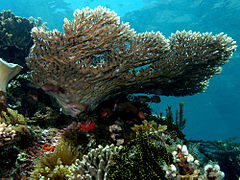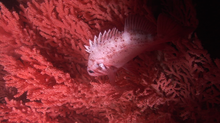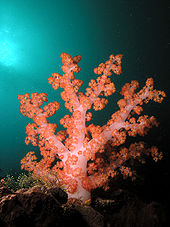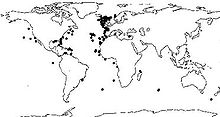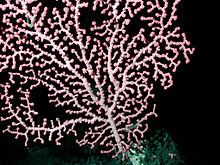- Deep water coral
-
The habitat of deep water corals, also known as cold water corals, extends to deeper, darker parts of the oceans than tropical corals, ranging from near the surface to the abyss, beyond 2,000 metres (6,600 ft) where water temperatures may be as cold as 4°C. Deep water corals belong to the Phylum Cnidaria and are most often stony corals, but also include black and horny corals and soft corals including the Gorgonians (sea fans).[1] Like tropical corals, they provide habitat to other species, but deep water coral do not require zooxanthellae to survive.
While there are nearly as many species of deep–water corals as shallow-water species, only a few deep-water species develop traditional reefs. Instead, they form aggregations called patches, banks, bioherms, massifs, thickets or groves. These aggregations are often referred to as "reefs," but differ structurally and functionally.[1] Deep sea reefs are sometimes referred to as "mounds," which more accurately describes the large calcium carbonate skeleton that is left behind as a reef grows and corals below die off, rather than the living habitat and refuge that deep sea corals provide for fish and invertebrates. Mounds may or may not contain living deep sea reefs.
Submarine communications cables and fishing methods such as bottom trawling tend to break corals apart and destroy reefs. The deep water habitat is designated as a United Kingdom Biodiversity Action Plan habitat.[2]
Contents
Discovery and study
Deep water corals are enigmatic because they construct their reefs in deep, dark, cool waters at high latitudes, such as Norway’s Continental Shelf. They were first discovered by fishermen about 250 years ago, which garnered interest from scientists.[3] Early scientists were unsure how the reefs sustained life in the seemingly barren and dark conditions of the northerly latitudes. It was not until modern times, when manned mini-submarines first reached sufficient depth, that scientists began to understand these organisms. Pioneering work by Wilson (1979)[4] shed light on a colony on the Porcupine Bank, off Ireland. The first ever live video of a large deep-water coral reef was obtained in July, 1982, when Statoil surveyed a 15 metres (49 ft) tall and 50 metres (160 ft) wide reef perched at 280 metres (920 ft) water depth near Fugløy Island, north of the Polar Circle, off northern Norway.[5]
During their survey of the Fugløy reef, Hovland and Mortensen[6] also found seabed pockmark craters near the reef. Since then, hundreds of large deep-water coral reefs have been mapped and studied. About 60 percent of the reefs occur next to or inside seabed pockmarks.[7][8] Because these craters are formed by the expulsion of liquids and gases (including methane), several scientists hypothesize that there may be a link between the existence of the deep-water coral reefs and nutrients seepage (light hydrocarbons, such as methane, ethane, and propane) through the seafloor. This hypothesis is called the 'hydraulic theory' for deep-water coral reefs.[9][10]
Lophelia communities support diverse marine life, such as sponges, polychaete worms, mollusks, crustaceans, brittle stars, starfish, sea urchins, bryozoans, sea spiders, fish and many other vertebrate and invertebrate species.[1]
The first international symposium for deep water corals took place in Halifax, Canada in 2000. The symposium considered all aspects of deep water corals, including protection methods.
In June 2009, Living Oceans Society led the Finding Coral Expedition on Canada’s Pacific coast in search of deep sea corals. Using one person submarines, a team of international scientists made 30 dives to depths of over 500 meters and saw giant coral forests, darting schools of fish, and a seafloor carpeted in brittle stars. During expedition, scientists identified 16 species of corals.[11] This research trip was the culmination of five years of work to secure protection from the Canadian Government for these slow-growing and long-lived animals, which provide critical habitat for fish and other marine creatures.
Taxonomy
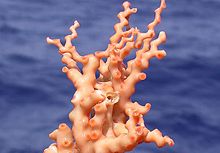 This beautiful species of Madrepora oculata coral was collected off the coast of South Carolina.
This beautiful species of Madrepora oculata coral was collected off the coast of South Carolina.
Corals are animals in the Phylum Cnidaria and the class Anthozoa. Anthozoa is broken down into two subclasses Octocorals (Alcyonaria) and Hexacorals (Zoantharia). Octocorals are soft corals such as sea pens. Hexacorals include sea anemones and hard bodied corals. Octocorals contain eight body extensions while Hexacorals have six. Most deep water corals are stony corals.
Distribution
Deep water coral are widely distributed within the earth’s oceans, with large reefs/beds in the far North and far South Atlantic, as well as in the tropics in places such as the Florida coast. In the north Atlantic, the principal coral species that contribute to reef formation are Lophelia pertusa, Oculina varicosa, Madrepora oculata, Desmophyllum cristagalli, Enallopsammia rostrata, Solenosmilia variabilis, and Goniocorella dumosa. Four genera (Lophelia, Desmophyllum, Solenosmilia, and Goniocorella) constitute most deep-water coral banks at depths of 400–700 metres (1,300–2,300 ft)[12]
Madrepora oculata occurs as deep as 2,020 m and is one of a dozen species that occur globally and in all oceans, including the Subantarctic (Cairns, 1982). Colonies of Enallopsammia contribute to the framework of deep-water coral banks found at depths of 600 to 800 m in the Straits of Florida (Cairns and Stanley, 1982).
Lophelia pertusa distribution
One of the most common species, Lophelia pertusa, lives in the Northeast and Northwest Atlantic Ocean, Brazil and off Africa’s west coast.
In addition to ocean bottoms, scientists find Lophelia colonies on North Sea oil installations, although oil and gas production may introduce noxious substances into the local environment.[13]
The world's largest known deep-water Lophelia coral complex is the Røst Reef. It lies between 300 and 400 metres (980 and 1,300 ft) deep, west of Røst island in the Lofoten archipelago, in Norway, inside the Arctic Circle. Discovered during a routine survey in May 2002, the reef is still largely intact. It is approximately 40 kilometres (25 mi) long by 3 kilometres (1.9 mi) wide.
Some 500 km further south is the Sula Reef, located on the Sula Ridge, west of Trondheim on the mid-Norwegian Shelf, at 200–300 metres (660–980 ft). It is 13 kilometres (8.1 mi) long, 700 metres (2,300 ft)wide, and up to 700 metres (2,300 ft) high [14] an area one-tenth the size of the 100 square kilometres (39 sq mi) Røst Reef.
Discovered and mapped in 2002, Norway's 1,000-year-old and 2 kilometres (1.2 mi) long Tisler Reef lies in the Skagerrak -- the submarine border between Norway and Sweden at a depth of 74–155 metres (243–509 ft). The Tisler Reef contains the world’s only known yellow L. pertusa. Elsewhere in the northeastern Atlantic, Lophelia is found around the Faroe Islands, an island group between the Norwegian Sea and the Northeast Atlantic Ocean. At depths from 200 to 500 metres (660 to 1,600 ft), L. pertusa is chiefly on the Rockall Bank and on the shelf break north and west of Scotland.[15] The Porcupine Seabight, the southern end of the Rockall Bank, and the shelf to the northwest of Donegal all exhibit large, mound-like Lophelia structures. One of them, the Therese Mound, is particularly noted for its Lophelia pertusa and Madrepora oculata colonies. Lophelia reefs are also found along the U.S. East Coast at depths of 500–850 metres (1,600–2,790 ft) along the base of the Florida-Hatteras slope. South of Cape Lookout, NC, rising from the flat sea bed of the Blake Plateau, is a band of ridges capped with thickets of Lophelia. These are the northernmost East Coast Lophelia pertusa growths. The coral mounds and ridges here rise as much as 150 metres (490 ft) from the plateau plain. These Lophelia communities lie in unprotected areas of potential oil and gas exploration and cable-laying operations, rendering them vulnerable to future threats.[16]
Lophelia exist around the Bay of Biscay, the Canary Islands, Portugal, Madeira, the Azores, and the western basin of the Mediterranean Sea.[17]
Darwin Mounds
Among the most researched deep-water coral areas in the United Kingdom are the Darwin Mounds. Atlantic Frontier Environmental Network (AFEN) discovered them in 1998 while conducting large-scale regional sea floor surveys north of Scotland. They discovered two areas of hundreds of sand and deep-water coral mounds at depths of about 1,000 metres (3,300 ft) in the northeast corner of the Rockall Trough, approximately 185 kilometres (115 mi) northwest of the northwest tip of Scotland. Named after the research vessel Charles Darwin, the Darwin Mounds have been extensively mapped using low-frequency side-scan sonar. They cover an area of approximately 100 square kilometres (39 sq mi) and consist of two main fields—the Darwin Mounds East, with about 75 mounds, and the Darwin Mounds West, with about 150 mounds. Other mounds are scattered in adjacent areas. Each mound is about 100 metres (330 ft) in diameter and 5 metres (16 ft) high. Lophelia corals and coral rubble cover the mound tops, attracting other marine life. The mounds look like 'sand volcanoes', each with a 'tail', up to several hundred meters long, all oriented downstream.[17] Large congregations of Xenophyophores (Syringammina fragilissima) which are giant unicellular organisms that can grow up to 25 centimetres (9.8 in) in diameter characterize the tails and mounds. Scientists are uncertain why these organisms congregate here. The Darwin Mounds Lophelia grow on sand rather than hard substrate, unique to this area. Lophelia corals exist in Irish waters as well.[18]
Oculina varicosa distribution
Oculina varicosa is a branching ivory coral that forms giant but slow-growing, bushy thickets on pinnacles up to 30 metres (98 ft) in height. The Oculina Banks, so named because they consist mostly of Oculina varicosa, exist in 50–100 metres (160–330 ft) of water along the continental shelf edge about −-760 miles (−38.6 km) off of Florida's central east coast.
Discovered in 1975 by scientists from the Harbor Branch Oceanographic Institution conducting surveys of the continental shelf, Oculina thickets grow on a series of pinnacles and ridges extending from Fort Pierce to Daytona, Florida[19][20][21] Like the Lophelia thickets, the Oculina Banks host a wide array of macroinvertebrates and fishes. They are significant spawning grounds for commercially important food species including gag, scamp, red grouper, speckled hind, black sea bass, red porgy, rock shrimp, and calico scallop.[22]
Growth and reproduction
Corals must attach to a hard surface in order to begin growing. They are often found growing along bathymetric highs such as seamounts, ridges, pinnacles and mounds, on hard surfaces. Corals are sedentary, so they must live near nutrient-rich water currents. Deep water corals feed on zooplankton and rely on ocean currents to bring food. The currents also aid in cleaning the corals.
Deep water corals grow more slowly than tropical corals because there are no zooxanthellae to feed them. Lophelia has a linear polyp extension of about 10 millimetres (0.39 in) per year. By contrast, branching shallow-water corals, such as Acropora, may exceed 10–20 cm/yr. Reef structure growth estimates are about 1 millimetre (0.039 in) per year.[23] Scientists have also found Lophelia colonies on oil installations in the North Sea.[13] Using coral age-dating methods, scientists have estimated that some living deep-water corals date back at least 10,000 years.[24]
Deep water corals use nematocysts on their tentacles to stun prey. Deep water corals feed on zooplankton, crustaceans and even krill.
Coral can reproduce sexually or asexually. In asexual reproduction (budding) a polyp divides in two genetically identical pieces. Sexual reproduction requires that a sperm fertilize an egg which grows into larva. Currents then disperse the larvae. Growth begins when the larvae attach to a solid substrate. Old/dead coral provides an excellent substrate for this growth, creating ever higher mounds of coral. As new growth surrounds the original, the new coral intercepts both water flow and accompanying nutrients, weakening and eventually killing the older organisms.
Individual Lophelia pertusa colonies are entirely either female or male.
Deep water coral colonies range in size from small and solitary to large, branching tree-like structures. Larger colonies support many life forms, while nearby areas have much less. The gorgonian, Paragorgia arborea, may grow beyond three meters.[25] However, little is known of their basic biology, including how they feed or their methods and timing of reproduction.
Importance
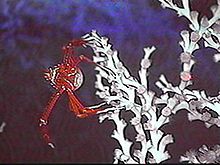 A squat lobster living on a Lophelia reef
A squat lobster living on a Lophelia reef
Lophelia reefs can host up to 1,300 species of fish and invertebrates. Fish aggregate on deep sea reefs that is precisely why, as one scientist puts it, “fishermen trawl them.” Deep sea corals, sponges and other habitat-forming animals provide protection from currents and predators, nurseries for young fish, and feeding, breeding and spawning areas for numerous fish and shellfish species. Rockfish, Atka mackerel, walleye pollock, Pacific cod, Pacific halibut, sablefish, flatfish, crabs, and other economically important species in the North Pacific inhabit these areas. Eighty-three percent of the rockfish found in one study were associated with red tree coral. Flatfish, walleye pollock and Pacific cod appear to be more commonly caught around soft corals. Dense schools of female redfish heavy with young have been observed on Lophelia reefs off Norway, suggesting the reefs are breeding or nursery areas for some species. Oculina reefs are important spawning habitat for several grouper species, as well as other fishes.[citation needed]
Human impact
The primary human impact on deep water corals is from deep water trawling. Trawlers drag nets across the ocean floor, disturbing sediments, breaking and destroying deep water corals. Another harmful method is long line fishing.
Oil and gas exploration also damage deep water coral.
Deep water corals grow slowly, so recovery takes much longer than in shallow waters where nutrients and food-providing zooxanthellae are far more abundant.
In a study during 2001 to 2003, a study of a reef of Lophelia pertusa in the Atlantic off Canada found that the corals were often broken in unnatural ways. And the ocean floor displayed scars and overturned boulders from trawling.[citation needed]
Oculina Banks
Bottom trawling and natural causes like bioerosion and episodic die-offs have reduced much of Florida's Oculina Banks to rubble, drastically reducing a once-substantial fishery by destroying spawning grounds.[21]
In 1980, Harbor Branch Oceanographic Institution scientists called for protective measures. In 1984, the South Atlantic Fishery Management Council (SAFMC) designated a 315 square kilometres (122 sq mi) area as a Habitat Area of Particular Concern. In 1994, an area called the Experimental Oculina Research Reserve was completely closed to bottom fishing. In 1996, the SAFMC prohibited fishing vessels from dropping anchors, grapples, or attached chains there. In 1998, the council also designated the reserve as an Essential Fish Habitat. In 2000, the deep-water Oculina Marine Protected Area was extended to 1,029 square kilometres (397 sq mi). Scientists recently deployed concrete reef balls in an attempt to provide habitat for fish and coral.
Sula and Røst
Scientists estimate that trawling has damaged or destroyed 30 to 50 percent of the Norwegian shelf coral area. The International Council for the Exploration of the Sea, the European Commission’s main scientific advisor on fisheries and environmental issues in the northeast Atlantic, recommend mapping and closing Europe’s deep corals to fishing trawlers.[1]
In 1999, the Norwegian Ministry of Fisheries closed an area of 1,000 square kilometres (390 sq mi) at Sula, including the large reef, to bottom trawling. In 2000, an additional area closed, covering about 600 square kilometres (230 sq mi). An area of about 300 square kilometres (120 sq mi) enclosing the Røst Reef, closed in 2002.[1]
Darwin mounds
The European Commission introduced an interim trawling ban in the Darwin Mounds area, in August 2003. A permanent ban is expected to follow.
See also
References
- ^ a b c d e "Deep Water Corals". http://coris.noaa.gov/about/deep/. Retrieved August 2009.
- ^ Tasker, M. (2007). "Action plan for Lophelia pertusa reefs". United Kingdom Biodiversity Action Plan. Joint Nature Conservation Committee. http://www.ukbap.org.uk/UKPlans.aspx?ID=45. Retrieved 2009-08-06.
- ^ [[Johan Ernst Gunnerus |Gunnerus, Johan Ernst]] (1768). Om Nogle Norske Coraller.
- ^ Wilson, J.B. (1979). "Biogenic carbonate sediments on the Scottish continental shelf and on Rockall Bank". Marine Geology (33): M85–M93.
- ^ Hovland, Martin (2008). Deep-water coral reefs: Unique Biodiversity hotspots.. Chichester, UK: Praxis Publishing (Springer). pp. 278.
- ^ Mortensen, P.B., Hovland, M.T., Fosså, J.H. and Furevik, D.M. (2001). "Distribution, abundance and size of Lophelia pertusa coral reefs in mid-Norway in relation to seabed characteristics". Journal Marine Biological Association U.K. 81 (4): 581–597. doi:10.1017/S002531540100426X.
- ^ LEWIS H KING and BRIAN MacLEAN (October 1970). "Pockmarks on the Scotian Shelf". GSA Bulletin (Geological Society of America) 81 (10): 3141–3148. doi:10.1130/0016-7606(1970)81[3141:POTSS]2.0.CO;2. ISSN 0016-7606.
- ^ Judd, A. and Hovland, M. (2007). Seabed Fluid Flow. Impact on Geology, Biology, and the Marine Environment. Cambridge University Press.
- ^ Hovland, M. and Thomsen, E. (1997). "Deep-water corals - are they hydrocarbon seep related?". Marine Geology: 137, 159–164.
- ^ Hovland and Risk, 2003
- ^ McKenna, S.A., Lash, J., Morgan, L., Reuscher, M., Shirley, T., Workman, G., Driscoll, J., Robb, C., Hangaard, D. (2009). Cruise Report for the Finding Coral Expedition. http://www.livingoceans.org/files/PDF/sustainable_fishing/cruise_report.pdf.
- ^ Cairns, S. and G. Stanley. "Ahermatypic coral banks: Living and fossil counterparts". Proceedings of the Fourth International Coral Reef Symposium, Manila (1981) 1: 611–618.
- ^ a b Bell, N. and J. Smith. "Coral growing on North Sea oil rigs". Nature 402 (6762): 601. doi:10.1038/45127. PMID 10604464.
- ^ Bellona Foundation (2001). "Coral reefs in Norwegian Waters".
- ^ Tyler-Walters, H. (2003). "Lophelia reefs". Plymouth, England: Marine Life Information Network: Biology and Sensitivity Key Information Sub-programme..
- ^ "A profile of the Lophelia reefs". 2001. http://oceanexplorer.noaa.gov/explorations/islands01/background/islands/sup10_lophelia.html.
- ^ a b Fosså, Jan Helge. "Coral reefs in the North Atlantic?". http://www.ices.dk/marineworld/deepseacoral.asp. Retrieved September 18, 2009.
- ^ Rogers, A.D. (1999). "The biology of Lophelia pertusa (Linnaeus 1758) and other deep-water reef-forming corals and impacts from human activities". International Review of Hydrobiology 84: 315–406.
- ^ Avent, R.M., King, M.E. and Gore, R.M. (1977). "Topographic and faunal studies of shelf-edge prominences off the central eastern Florida coast". Revue ges.Hydrobiol 62: 185–208.
- ^ Reed, J.K. (1981). W.J. Richards. ed. "In situ growth rates of the scleractinian coral Oculina varicosa occurring with zooxanthellae on 6-m reefs and without on 80-m banks". Proceedings of Marine Recreational Fisheries Symposium: 201–206.
- ^ a b Reed, J.K. (2002). "Comparison of deep-water coral reefs and lithoherms off southeastern U.S.A". Hydrobiologia 471: 43–55. doi:10.1023/A:1016588901551.
- ^ C. Koenig, J. Reid, K. Scanlon, F. Coleman. "Studies in the Experimental Oculina Research Reserve off the Atlantic Coast of Florida". http://www.bio.fsu.edu/ifre/ifre_research_oculina.html. Retrieved September 18, 2009.[dead link]
- ^ Fossa, J.H., P.B. Mortensen, and D.M. Furevic (2002). "The deep-water coral Lophelia pertusa in Norwegian waters: distribution and fishery impacts". Hydrobiologia (417): 1–12.
- ^ Mayer, T. (2001). 2000 Years Under the Sea.
- ^ Watling, L. (2001). "Deep sea coral". http://oceanexplorer.noaa.gov/explorations/deepeast01/background/corals/corals.html.
External references
- http://www.findingcoral.com
- http://www.martinhovland.com/
- http://www.lophelia.org/
- http://www.martinhovland.com
- http://news.nationalgeographic.com/news/2006/05/0501_060501_coral.html. National Geographic. Retrieved on 2008-March-30.
- Thorsnes, T. and Fosså, J. H. (April 2004). http://www.hydro-international.com/issues/articles/id293-Deepwater_Coral_Reefs.html. Hydro International.
- Hovland, M., Mortensen, P.B., Thomsen, P.B. and Brattegard, T., 1997. Substratum-related ahermatypic coral banks on the Norwegian continental shelf. Proc. 8th Int. Coral Reef Sym., 2, 1203-1206.
- Rogers, A. (2004). http://www.iucn.org/THEMES/MARINE/pdf/AlexRogers-CBDCOP7-DeepWaterCorals-Complete.pdf The World Conservation Union (IUCN).
- http://www.lophelia.org/lophelia/basics3d1.htm. Lophelia.org. Retrieved on 2008-March-30.
- Mortensen, P. B. (April 2006). Deep Corals in Atlantic Canada: A Summary of ESRF-Funded Research (2001–2003):13-60.
- http://www.unep.org/cold_water_reefs/comparison.htm. UNEP. Retrieved on 2008-March-30.
- http://seattletimes.nwsource.com/html/localnews/2002177305_coral11m.html. The Seattle Times. Retrieved on 2008-March-30
- http://news.bbc.co.uk/1/hi/sci/tech/1835951.stm. BBC News. Retrieved on 2008-March-30
- http://www.marinebiodiversity.ca/CoralWebsite/Homepagecorals.htm. Retrieved on 2008-March-30
- http://www.mar.dfo-mpo.gc.ca/communications/maritimes/back02e/B-MAR-02-(5E).html. Fisheries and Oceans Canada. Retrieved on 2008-March -30.
- Roberts, S; Hirshfield, M (April 2004). "Deep Sea Corals: Out of Sight, But No Longer Out of Mind". Frontiers in Ecology and the Environment (Oceania). http://www.oceana.org/fileadmin/oceana/uploads/destructive_trawling/savecorals/News/oceana_coral_report_old.pdf.
- Action plan for Lophelia pertusa reefs on the UK BAP website.
Corals and coral reefs Stony corals 
Soft corals - Alcyonacea
- Black coral
- Bamboo coral
- Organ pipe coral
- Sea fans
- Sea pens
Coral reefs - Atoll reef
- Cay
- Fringing reef
- Microatoll
- Coral reef fish
- Census of Coral Reefs
- The Structure and Distribution of Coral Reefs
Coral regions Coral diseases - Coral bleaching
- Black band disease
- Skeletal eroding band
- White band disease
- White pox disease
Protection - Coral reef protection
- Project AWARE
- Reef Check
- Reef Ball
- Coral Reef Alliance
- International Society for Reef Studies
Other - Artificial reef
- Coral aquaculture
- Coral dermatitis
- Coral (precious)
- Coral rag
- Coral sand
- Coralline algae
- Human impact
- Fire coral
- Rugosa (extinct)
- Tabulate (extinct)
- Zooxanthella
Categories:- Anthozoa
- UK BAP habitats
- Coral reefs
Wikimedia Foundation. 2010.

